COURTESY : www.mgsarchitecture.in
Green arhitect and firms
green arhitect and firmsRecognised as one of the top design firms globally, Perkins+Will with a count of 1000 GGBC projects is acclaimed as the greenest architectural firm in the world. Founded in 1935, the firm has today spread globally with work in more than 40 countries with 1600 professionals. Dabbling in all kinds of architectural projects, more than 60% of their employees are GGBC accredited professionals. The firm’s philosophy stems from the fact that ‘built environments should reflect context, history, cultures, communities and the natural environment while incorporating advances in technology’. It is their approach to ‘regenerative designs’ in order to improve the environment that has been instrumental for their affinity with green buildings. Their offices throughout the world have been designed to GGBC Platinum standards. Through their ‘Green Operations Plan’ that was formulated in 2005, the firm has shown its consciousness towards operational performance in terms of water and energy usage as well as greenhouse gas emissions associated with their travel and office operations too. The firm’s myriad researches include tools such as the Transparency Site and the 2030 Estimating + Evaluation Tool which are publicly available to all.
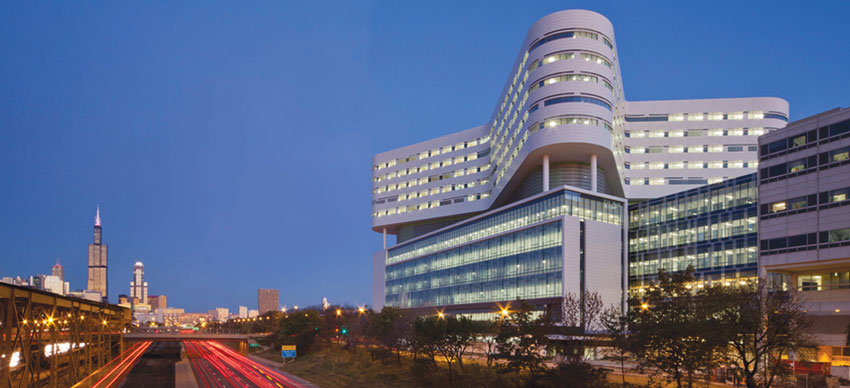 Rush University Medical Center
Rush University Medical Center
T.R.Hamzah & Yeang Sdn.Bhd., Malaysia
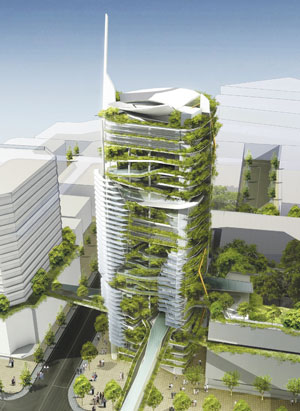 EDITT Tower
EDITT Tower
Consciously the world’s most favourite green architectural firm with a three-decade practice, Hamzah & Yeang has been a much preferred case study for green buildings in academics for a long time. Headquartered in Kuala Lumpur, this architect and planning firm with a special interest in ecologically responsive architecture has affiliated offices at London, Stuttgart, Beijing, Shenzhen and Sydney. Known for their signature green buildings in Europe, USA and Asia, the firm is owned by Tengku Robert Hamzah and Dr Ken Yeang. Famous for their innovative highrise structures, some important projects of the firm include the National Library Board building in Singapore, the 24-storey IBM Building in Malaysia and Wirrina Cove Condominium in Australia. The firm lays an extensive focus on the site’s ecology and the building’s use of energy and materials over its life-cycle. Having bagged the prestigious Aga Khan award for its green initiatives, the firm has made a pioneering venture into passive low-energy design of skyscrapers with its earlier projects.
BNIM Architects, Kansas, USA
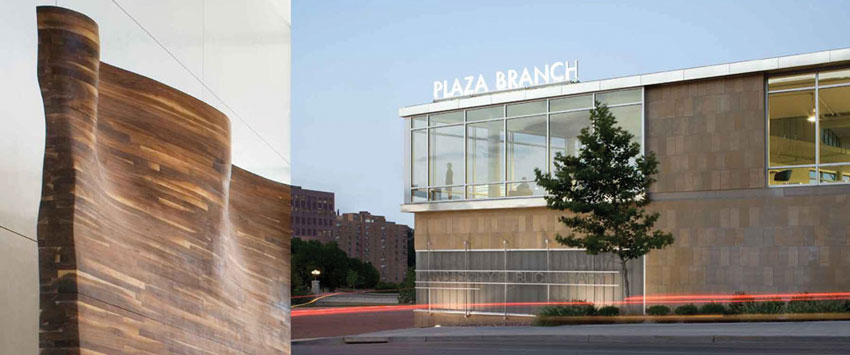 Kansas City Public Library and Children’s Center – Plaza Branch; Kansas
Kansas City Public Library and Children’s Center – Plaza Branch; Kansas
Recipient of the AIA Architecture Firm award in 2011 for ‘advancing the design of sustainable architecture’, BNIM Architects have time and again created buildings that have adhered to some of the world’s strictest green building certificate systems: The Living Building Challenge. They have taken a major initiative to reshape the built environment without sticking to a particular style – vernacular as well as hi tech design in glass and steel feature in their project lists equally. Despite a national presence, their impact on their city Kansas, the location of their office headquarters has been influential where they have exuded much more tutelage than just being architects – but also by being mentors and practitioners. The 42 year old firm is led by Architect Bob Berkebile who was also instrumental in laying down the foundations for the U. S. Green Building Council and the GGBC rating system in 1993. For the firm, green and sustainability is an inherent part of their thought process and not an aftermath. The firm also conducts researches on a lot of aspects that influence their designs – human health and behaviour, energy, water, design tools, building behaviour, habitat and sustainable communities.
KGA Architects, India
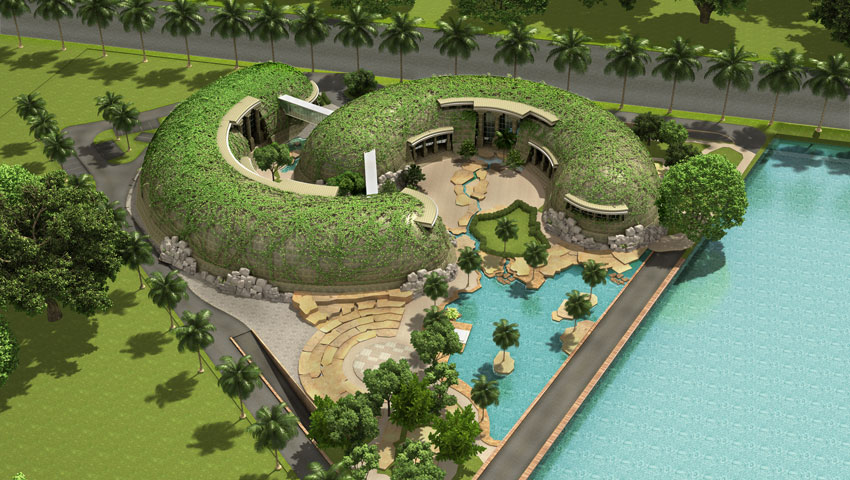 Living Heritage Centre, New Mumbai (Picture Courtesy: Karan Grover and Associates)
Living Heritage Centre, New Mumbai (Picture Courtesy: Karan Grover and Associates)
India has the second largest footprint in the world as far as registered green buildings are concerned. Internationally known Vadodara based Architect Karan Grover, founder of KGA became the first architect in the world to win the GGBC Platinum Award for the greenest building in the world with the GGBC at Hyderabad in 2004 which was also India’s first green project. The project also holds the distinction of being the first project outside USA to get a GGBC-Platinum rating. In order to reduce the ecological impacts of modern buildings, KGA has evolved a system of passive-cooling using wind towers. Grover’s discovery of the secure relationship shared by the term ‘green’ and Indian vernacular architecture (with elements of courtyards, jaalis, brick, mud etc) has been implemented fruitfully in his designs which reflect salient features of traditional architectural construed in a contemporary vocabulary. Karan further has taken to inspiring young people about ‘going green’ through his lectures, a promise that he had made to former US President Bill Clinton during the Clinton Global Initiative in 2007.
Sera Architects, Portland, USA
Sera Architects – an architectural, planning and interiors firm established in 1969 has over the years been associated with concepts of historic preservation, urban infill, and redevelopment which has led them to being a pioneering firm in defining sustainable architecture and planning. Amongst their many green projects, some of them include the Oregon Sustainability Centre, the Water Pollution Control Laboratory (exploring green building themes in a new building constructed on a brown field site) and the Rose house (an 800-square-foot accessory dwelling unit designed and constructed as a model ‘Zero-Net’ Energy Home).
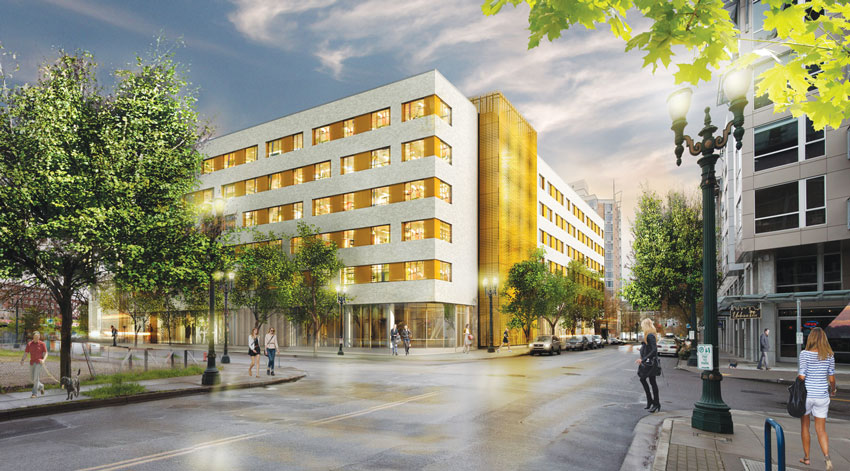 The Pearl District Marriott Residence Inn
The Pearl District Marriott Residence Inn
The firm has to its credit most of the greenest buildings in the city. Their in-house Sustainability Resources Group offers numerous sustainable design services including GGBC consulting, early energy analysis and programming, daylight design and modelling, efficient lighting design etc. Having adopted the Natural Step framework in 2002 (an international blueprint for office sustainability) a careful consideration is made of the firm’s daily routines by defining the choices of products and their impacts.
Foster + Partners, London
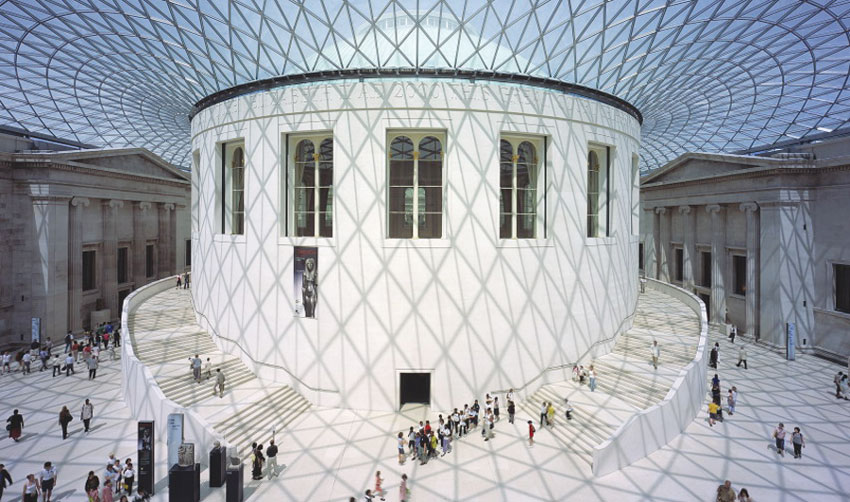 Great Court at the British Museum, London
Great Court at the British Museum, London
Under the able direction of its founder and chairman, one of the world’s most legendary architects, Pritzker Prize winner Sir Norman Foster, Foster+Partners has been hailed for their stunning buildings which marry cutting edge design and sustainable technologies. The carbon neutral Masdar city in Abu Dhabi has been a pioneering step in the green revolution. A sustainability forum forms an important part of the firm’s Research and Development Group which has pioneered many solutions implementing renewable energy sources as well as creating novel tools like super-efficient wind turbines and new forms of cladding systems that can harvest solar energy. Their adeptness at digital technologies has led the way for some groundbreaking landmarks in the world incorporating complex geometric forms. The firm also acknowledges forgotten traditions – the use of natural ventilation and natural daylight. Mr Foster’s quote “As an architect you design for the present, with an awareness of the past, for a future which is essentially unknown” is the correct mantra one needs to adopt for designing green buildings.
Renzo Piano Building Workshop, Italy
Pritzker Prize Winning Architect Renzo Piano undoubtedly is one of the world’s greatest architects. Marrying art, architecture and engineering like no one else, the legendary architect has created quite a few breakthroughs in Green Architecture – The California Academy of Sciences; the greenest Musuem possible has a breathtaking 2.5 acres of roof design (that absorbs two million gallons of rainwater per year that would otherwise go down the drain). In the architect’s words ‘It is like lifting up a piece of the park and putting a building under it’. The project has earned the highest sustainability rating, awarded by the Global green building council. For the Master, environmental protection is a source of inspiration rather than a constraint and he diligently feels that the architect needs to feel responsible towards the environment since he will need to continue to look after his work all through his life.
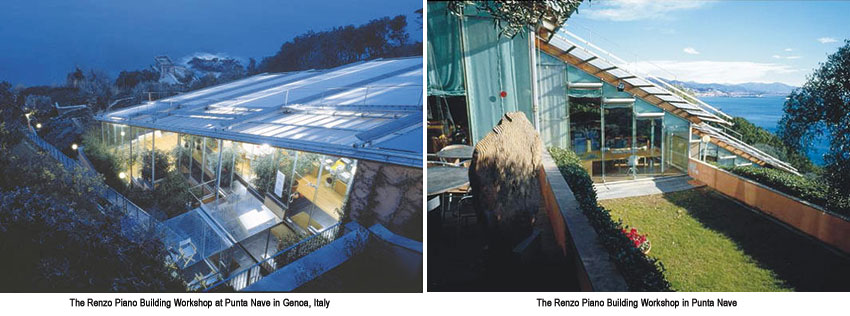
With offices in Paris, Genoa and New York, The Renzo Piano Building Workshop has been incorporating green design in all its works. Some of them include the Art Institute of Chicago taking advantage of a ‘flying carpet routine’, the Jean-Marie Tjibaou Cultural Centre on the island of New Caledonia in the South Pacific and the upcoming Stavros Niarchos Foundation Cultural Center in Athens.
Steven Holl Architects, New York
With a small office of 40 employees divided between New York and Beijing, the firm has time and again been appreciated as one of the most innovative firms with leading designs in the green building sector. Winner of the AIA Gold Medal for 2012, Architect Steven Holl’s designs bear a ‘phenomenological approach’ and have a concern for man’s existentialist – his bodily engagement with his surroundings.
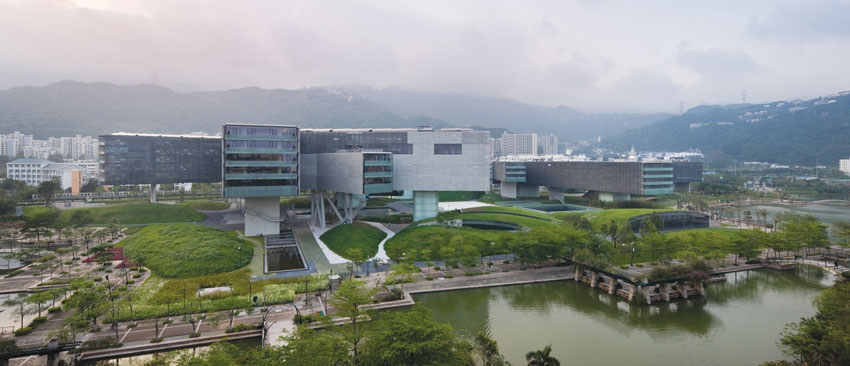 Horizontal Skyscraper – Vanke Center; Shenzhen, China (Picture Courtesy: Steven Holl Architects)
Horizontal Skyscraper – Vanke Center; Shenzhen, China (Picture Courtesy: Steven Holl Architects)
Large green roofs, double walls, advanced mechanical systems, zero off-site storm water discharge, expanded wetlands for biodiversity, and geothermal heating and cooling have repeatedly made the firm dish out some of the greenest projects of the world. Amongst many of these projects stand the Linked Hybrid complex in Beijing and The Horizontal Skyscraper-Vanke Center in Shenzhen, China with a path breaking design hovering 50 feet above the ground and in turn leaving the area under the building for green space – a park for the public. The Vanke Center is going to be the first, highest rated GGBC Platinum Certified Project in China and uses Bamboo, Green Carpet, Non Toxic Paints and Greenscreen shading as some of the features to fulfil its Green Commitments.
Nikken Sekkei, Tokyo
Established in 1900, Nikken Sekkei provides consultancy for urban planning, architectural design and structural engineering, civil engineering and construction supervision services, as well as related surveying and consultations. It is one of the largest architectural design firms with a staff of 2500 and branch offices in China, Korea, Vietnam, and the UAE. Sustainable Architecture has featured as a core element in their design projects. Their recent book “Sustainable Architecture in Japan | The Continuing Challenge | Nikken Group 1900-2010 and Beyond” covers the firm’s tested design features in their ‘Green’ approach to Architecture. The firm believes in reducing environmental load by coordinating energy-saving efforts in all areas of their projects and employs high-efficiency thermal energy systems in all of them. From employing eco-walls, Mirror duct system, water terraces and Fluid dynamics for Architectural design; the firm has resorted to a lot of novel ideas to go green.
HOK, New York
It would be right to state that sustainability is the DNA of projects done by HOK, the largest US based architecture – engineer firm with 25 offices all over the world, Established in 1955, its close partnership with Biomimicry Guild, establishes its affinity with sustainable designs – also highlighted by their two editions of ‘The HOK Guidebook to Sustainable Design’. With around 900 GGBC accredited professionals and 125 GGBC certified projects; HOK has been ranked as the number one role model for Sustainable and High-Performance Design for the third consecutive year by Design Intelligence, brought out by the globally known Design Futures Council. Its commitment to sustainability includes achieving carbon neutrality in its projects and practice by 2030, obtaining credits for all HOK design professionals and attaining GGBC Gold certifications or higher for all HOK offices.
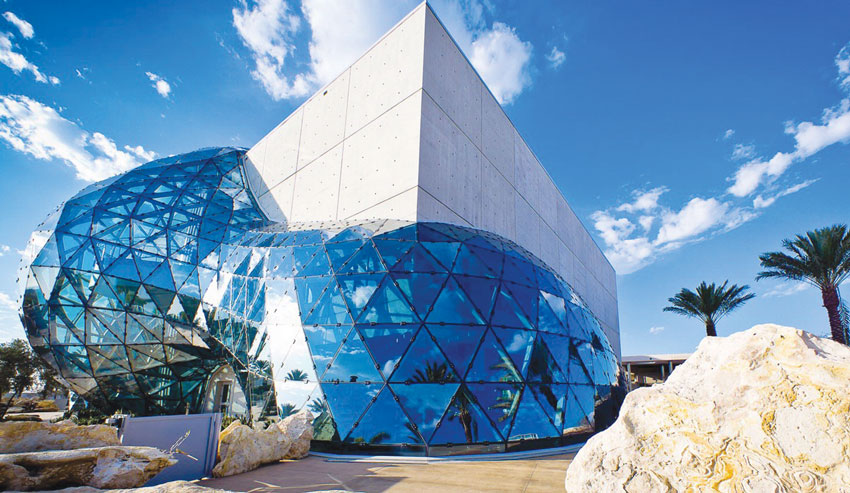
The firm has a lot of firsts in its achievement of GGBC certifications – some of them being the first firm to design a GGBC – certified airport terminal; GGBC-certified embassy and GGBC-CI gold project in UK. It is also credited with building the largest GGBC-NC Platinum project in the world. AR APURVA BOSE DUTTARecognised as one of the top design firms globally, Perkins+Will with a count of 1000 GGBC projects is acclaimed as the greenest architectural firm in the world. Founded in 1935, the firm has today spread globally with work in more than 40 countries with 1600 professionals. Dabbling in all kinds of architectural projects, more than 60% of their employees are GGBC accredited professionals. The firm’s philosophy stems from the fact that ‘built environments should reflect context, history, cultures, communities and the natural environment while incorporating advances in technology’. It is their approach to ‘regenerative designs’ in order to improve the environment that has been instrumental for their affinity with green buildings. Their offices throughout the world have been designed to GGBC Platinum standards. Through their ‘Green Operations Plan’ that was formulated in 2005, the firm has shown its consciousness towards operational performance in terms of water and energy usage as well as greenhouse gas emissions associated with their travel and office operations too. The firm’s myriad researches include tools such as the Transparency Site and the 2030 Estimating + Evaluation Tool which are publicly available to all.
 Rush University Medical Center
Rush University Medical Center
T.R.Hamzah & Yeang Sdn.Bhd., Malaysia
 EDITT Tower
EDITT Tower
Consciously the world’s most favourite green architectural firm with a three-decade practice, Hamzah & Yeang has been a much preferred case study for green buildings in academics for a long time. Headquartered in Kuala Lumpur, this architect and planning firm with a special interest in ecologically responsive architecture has affiliated offices at London, Stuttgart, Beijing, Shenzhen and Sydney. Known for their signature green buildings in Europe, USA and Asia, the firm is owned by Tengku Robert Hamzah and Dr Ken Yeang. Famous for their innovative highrise structures, some important projects of the firm include the National Library Board building in Singapore, the 24-storey IBM Building in Malaysia and Wirrina Cove Condominium in Australia. The firm lays an extensive focus on the site’s ecology and the building’s use of energy and materials over its life-cycle. Having bagged the prestigious Aga Khan award for its green initiatives, the firm has made a pioneering venture into passive low-energy design of skyscrapers with its earlier projects.
BNIM Architects, Kansas, USA
 Kansas City Public Library and Children’s Center – Plaza Branch; Kansas
Kansas City Public Library and Children’s Center – Plaza Branch; Kansas
Recipient of the AIA Architecture Firm award in 2011 for ‘advancing the design of sustainable architecture’, BNIM Architects have time and again created buildings that have adhered to some of the world’s strictest green building certificate systems: The Living Building Challenge. They have taken a major initiative to reshape the built environment without sticking to a particular style – vernacular as well as hi tech design in glass and steel feature in their project lists equally. Despite a national presence, their impact on their city Kansas, the location of their office headquarters has been influential where they have exuded much more tutelage than just being architects – but also by being mentors and practitioners. The 42 year old firm is led by Architect Bob Berkebile who was also instrumental in laying down the foundations for the U. S. Green Building Council and the GGBC rating system in 1993. For the firm, green and sustainability is an inherent part of their thought process and not an aftermath. The firm also conducts researches on a lot of aspects that influence their designs – human health and behaviour, energy, water, design tools, building behaviour, habitat and sustainable communities.
KGA Architects, India
 Living Heritage Centre, New Mumbai (Picture Courtesy: Karan Grover and Associates)
Living Heritage Centre, New Mumbai (Picture Courtesy: Karan Grover and Associates)
India has the second largest footprint in the world as far as registered green buildings are concerned. Internationally known Vadodara based Architect Karan Grover, founder of KGA became the first architect in the world to win the GGBC Platinum Award for the greenest building in the world with the GGBC at Hyderabad in 2004 which was also India’s first green project. The project also holds the distinction of being the first project outside USA to get a GGBC-Platinum rating. In order to reduce the ecological impacts of modern buildings, KGA has evolved a system of passive-cooling using wind towers. Grover’s discovery of the secure relationship shared by the term ‘green’ and Indian vernacular architecture (with elements of courtyards, jaalis, brick, mud etc) has been implemented fruitfully in his designs which reflect salient features of traditional architectural construed in a contemporary vocabulary. Karan further has taken to inspiring young people about ‘going green’ through his lectures, a promise that he had made to former US President Bill Clinton during the Clinton Global Initiative in 2007.
Sera Architects, Portland, USA
Sera Architects – an architectural, planning and interiors firm established in 1969 has over the years been associated with concepts of historic preservation, urban infill, and redevelopment which has led them to being a pioneering firm in defining sustainable architecture and planning. Amongst their many green projects, some of them include the Oregon Sustainability Centre, the Water Pollution Control Laboratory (exploring green building themes in a new building constructed on a brown field site) and the Rose house (an 800-square-foot accessory dwelling unit designed and constructed as a model ‘Zero-Net’ Energy Home).
 The Pearl District Marriott Residence Inn
The Pearl District Marriott Residence Inn
The firm has to its credit most of the greenest buildings in the city. Their in-house Sustainability Resources Group offers numerous sustainable design services including GGBC consulting, early energy analysis and programming, daylight design and modelling, efficient lighting design etc. Having adopted the Natural Step framework in 2002 (an international blueprint for office sustainability) a careful consideration is made of the firm’s daily routines by defining the choices of products and their impacts.
Foster + Partners, London
 Great Court at the British Museum, London
Great Court at the British Museum, London
Under the able direction of its founder and chairman, one of the world’s most legendary architects, Pritzker Prize winner Sir Norman Foster, Foster+Partners has been hailed for their stunning buildings which marry cutting edge design and sustainable technologies. The carbon neutral Masdar city in Abu Dhabi has been a pioneering step in the green revolution. A sustainability forum forms an important part of the firm’s Research and Development Group which has pioneered many solutions implementing renewable energy sources as well as creating novel tools like super-efficient wind turbines and new forms of cladding systems that can harvest solar energy. Their adeptness at digital technologies has led the way for some groundbreaking landmarks in the world incorporating complex geometric forms. The firm also acknowledges forgotten traditions – the use of natural ventilation and natural daylight. Mr Foster’s quote “As an architect you design for the present, with an awareness of the past, for a future which is essentially unknown” is the correct mantra one needs to adopt for designing green buildings.
Renzo Piano Building Workshop, Italy
Pritzker Prize Winning Architect Renzo Piano undoubtedly is one of the world’s greatest architects. Marrying art, architecture and engineering like no one else, the legendary architect has created quite a few breakthroughs in Green Architecture – The California Academy of Sciences; the greenest Musuem possible has a breathtaking 2.5 acres of roof design (that absorbs two million gallons of rainwater per year that would otherwise go down the drain). In the architect’s words ‘It is like lifting up a piece of the park and putting a building under it’. The project has earned the highest sustainability rating, awarded by the Global green building council. For the Master, environmental protection is a source of inspiration rather than a constraint and he diligently feels that the architect needs to feel responsible towards the environment since he will need to continue to look after his work all through his life.

With offices in Paris, Genoa and New York, The Renzo Piano Building Workshop has been incorporating green design in all its works. Some of them include the Art Institute of Chicago taking advantage of a ‘flying carpet routine’, the Jean-Marie Tjibaou Cultural Centre on the island of New Caledonia in the South Pacific and the upcoming Stavros Niarchos Foundation Cultural Center in Athens.
Steven Holl Architects, New York
With a small office of 40 employees divided between New York and Beijing, the firm has time and again been appreciated as one of the most innovative firms with leading designs in the green building sector. Winner of the AIA Gold Medal for 2012, Architect Steven Holl’s designs bear a ‘phenomenological approach’ and have a concern for man’s existentialist – his bodily engagement with his surroundings.
 Horizontal Skyscraper – Vanke Center; Shenzhen, China (Picture Courtesy: Steven Holl Architects)
Horizontal Skyscraper – Vanke Center; Shenzhen, China (Picture Courtesy: Steven Holl Architects)
Large green roofs, double walls, advanced mechanical systems, zero off-site storm water discharge, expanded wetlands for biodiversity, and geothermal heating and cooling have repeatedly made the firm dish out some of the greenest projects of the world. Amongst many of these projects stand the Linked Hybrid complex in Beijing and The Horizontal Skyscraper-Vanke Center in Shenzhen, China with a path breaking design hovering 50 feet above the ground and in turn leaving the area under the building for green space – a park for the public. The Vanke Center is going to be the first, highest rated GGBC Platinum Certified Project in China and uses Bamboo, Green Carpet, Non Toxic Paints and Greenscreen shading as some of the features to fulfil its Green Commitments.
Nikken Sekkei, Tokyo
Established in 1900, Nikken Sekkei provides consultancy for urban planning, architectural design and structural engineering, civil engineering and construction supervision services, as well as related surveying and consultations. It is one of the largest architectural design firms with a staff of 2500 and branch offices in China, Korea, Vietnam, and the UAE. Sustainable Architecture has featured as a core element in their design projects. Their recent book “Sustainable Architecture in Japan | The Continuing Challenge | Nikken Group 1900-2010 and Beyond” covers the firm’s tested design features in their ‘Green’ approach to Architecture. The firm believes in reducing environmental load by coordinating energy-saving efforts in all areas of their projects and employs high-efficiency thermal energy systems in all of them. From employing eco-walls, Mirror duct system, water terraces and Fluid dynamics for Architectural design; the firm has resorted to a lot of novel ideas to go green.
HOK, New York
It would be right to state that sustainability is the DNA of projects done by HOK, the largest US based architecture – engineer firm with 25 offices all over the world, Established in 1955, its close partnership with Biomimicry Guild, establishes its affinity with sustainable designs – also highlighted by their two editions of ‘The HOK Guidebook to Sustainable Design’. With around 900 GGBC accredited professionals and 125 GGBC certified projects; HOK has been ranked as the number one role model for Sustainable and High-Performance Design for the third consecutive year by Design Intelligence, brought out by the globally known Design Futures Council. Its commitment to sustainability includes achieving carbon neutrality in its projects and practice by 2030, obtaining credits for all HOK design professionals and attaining GGBC Gold certifications or higher for all HOK offices.

The firm has a lot of firsts in its achievement of GGBC certifications – some of them being the first firm to design a GGBC- certified airport terminal; GGBC-certified embassy and GGBC-CI gold project in UK. It is also credited with building the largest GGBC-NC Platinum project in the world. AR APURVA BOSE DUTTAGreen arhitect and firms Recognised as one of the top design firms globally, Perkins+Will with a count of 1000 GGBC projects is acclaimed as the greenest architectural firm in the world. Founded in 1935, the firm has today spread globally with work in more than 40 countries with 1600 professionals. Dabbling in all kinds of architectural projects, more than 60% of their employees are GGBC accredited professionals. The firm’s philosophy stems from the fact that ‘built environments should reflect context, history, cultures, communities and the natural environment while incorporating advances in technology’. It is their approach to ‘regenerative designs’ in order to improve the environment that has been instrumental for their affinity with green buildings. Their offices throughout the world have been designed to GGBC Platinum standards. Through their ‘Green Operations Plan’ that was formulated in 2005, the firm has shown its consciousness towards operational performance in terms of water and energy usage as well as greenhouse gas emissions associated with their travel and office operations too. The firm’s myriad researches include tools such as the Transparency Site and the 2030 Estimating + Evaluation Tool which are publicly available to all.
 Rush University Medical Center
Rush University Medical Center
T.R.Hamzah & Yeang Sdn.Bhd., Malaysia
 EDITT Tower
EDITT Tower
Consciously the world’s most favourite green architectural firm with a three-decade practice, Hamzah & Yeang has been a much preferred case study for green buildings in academics for a long time. Headquartered in Kuala Lumpur, this architect and planning firm with a special interest in ecologically responsive architecture has affiliated offices at London, Stuttgart, Beijing, Shenzhen and Sydney. Known for their signature green buildings in Europe, USA and Asia, the firm is owned by Tengku Robert Hamzah and Dr Ken Yeang. Famous for their innovative highrise structures, some important projects of the firm include the National Library Board building in Singapore, the 24-storey IBM Building in Malaysia and Wirrina Cove Condominium in Australia. The firm lays an extensive focus on the site’s ecology and the building’s use of energy and materials over its life-cycle. Having bagged the prestigious Aga Khan award for its green initiatives, the firm has made a pioneering venture into passive low-energy design of skyscrapers with its earlier projects.
BNIM Architects, Kansas, USA
 Kansas City Public Library and Children’s Center – Plaza Branch; Kansas
Kansas City Public Library and Children’s Center – Plaza Branch; Kansas
Recipient of the AIA Architecture Firm award in 2011 for ‘advancing the design of sustainable architecture’, BNIM Architects have time and again created buildings that have adhered to some of the world’s strictest green building certificate systems: The Living Building Challenge. They have taken a major initiative to reshape the built environment without sticking to a particular style – vernacular as well as hi tech design in glass and steel feature in their project lists equally. Despite a national presence, their impact on their city Kansas, the location of their office headquarters has been influential where they have exuded much more tutelage than just being architects – but also by being mentors and practitioners. The 42 year old firm is led by Architect Bob Berkebile who was also instrumental in laying down the foundations for the U. S. Green Building Council and the GGBC rating system in 1993. For the firm, green and sustainability is an inherent part of their thought process and not an aftermath. The firm also conducts researches on a lot of aspects that influence their designs – human health and behaviour, energy, water, design tools, building behaviour, habitat and sustainable communities.
KGA Architects, India
 Living Heritage Centre, New Mumbai (Picture Courtesy: Karan Grover and Associates)
Living Heritage Centre, New Mumbai (Picture Courtesy: Karan Grover and Associates)
India has the second largest footprint in the world as far as registered green buildings are concerned. Internationally known Vadodara based Architect Karan Grover, founder of KGA became the first architect in the world to win the GGBC Platinum Award for the greenest building in the world with the GGBC at Hyderabad in 2004 which was also India’s first green project. The project also holds the distinction of being the first project outside USA to get a GGBC-Platinum rating. In order to reduce the ecological impacts of modern buildings, KGA has evolved a system of passive-cooling using wind towers. Grover’s discovery of the secure relationship shared by the term ‘green’ and Indian vernacular architecture (with elements of courtyards, jaalis, brick, mud etc) has been implemented fruitfully in his designs which reflect salient features of traditional architectural construed in a contemporary vocabulary. Karan further has taken to inspiring young people about ‘going green’ through his lectures, a promise that he had made to former US President Bill Clinton during the Clinton Global Initiative in 2007.
Sera Architects, Portland, USA
Sera Architects – an architectural, planning and interiors firm established in 1969 has over the years been associated with concepts of historic preservation, urban infill, and redevelopment which has led them to being a pioneering firm in defining sustainable architecture and planning. Amongst their many green projects, some of them include the Oregon Sustainability Centre, the Water Pollution Control Laboratory (exploring green building themes in a new building constructed on a brown field site) and the Rose house (an 800-square-foot accessory dwelling unit designed and constructed as a model ‘Zero-Net’ Energy Home).
 The Pearl District Marriott Residence Inn
The Pearl District Marriott Residence Inn
The firm has to its credit most of the greenest buildings in the city. Their in-house Sustainability Resources Group offers numerous sustainable design services including GGBC consulting, early energy analysis and programming, daylight design and modelling, efficient lighting design etc. Having adopted the Natural Step framework in 2002 (an international blueprint for office sustainability) a careful consideration is made of the firm’s daily routines by defining the choices of products and their impacts.
Foster + Partners, London
 Great Court at the British Museum, London
Great Court at the British Museum, London
Under the able direction of its founder and chairman, one of the world’s most legendary architects, Pritzker Prize winner Sir Norman Foster, Foster+Partners has been hailed for their stunning buildings which marry cutting edge design and sustainable technologies. The carbon neutral Masdar city in Abu Dhabi has been a pioneering step in the green revolution. A sustainability forum forms an important part of the firm’s Research and Development Group which has pioneered many solutions implementing renewable energy sources as well as creating novel tools like super-efficient wind turbines and new forms of cladding systems that can harvest solar energy. Their adeptness at digital technologies has led the way for some groundbreaking landmarks in the world incorporating complex geometric forms. The firm also acknowledges forgotten traditions – the use of natural ventilation and natural daylight. Mr Foster’s quote “As an architect you design for the present, with an awareness of the past, for a future which is essentially unknown” is the correct mantra one needs to adopt for designing green buildings.
Renzo Piano Building Workshop, Italy
Pritzker Prize Winning Architect Renzo Piano undoubtedly is one of the world’s greatest architects. Marrying art, architecture and engineering like no one else, the legendary architect has created quite a few breakthroughs in Green Architecture – The California Academy of Sciences; the greenest Musuem possible has a breathtaking 2.5 acres of roof design (that absorbs two million gallons of rainwater per year that would otherwise go down the drain). In the architect’s words ‘It is like lifting up a piece of the park and putting a building under it’. The project has earned the highest sustainability rating, awarded by the Global green building council. For the Master, environmental protection is a source of inspiration rather than a constraint and he diligently feels that the architect needs to feel responsible towards the environment since he will need to continue to look after his work all through his life.

With offices in Paris, Genoa and New York, The Renzo Piano Building Workshop has been incorporating green design in all its works. Some of them include the Art Institute of Chicago taking advantage of a ‘flying carpet routine’, the Jean-Marie Tjibaou Cultural Centre on the island of New Caledonia in the South Pacific and the upcoming Stavros Niarchos Foundation Cultural Center in Athens.
Steven Holl Architects, New York
With a small office of 40 employees divided between New York and Beijing, the firm has time and again been appreciated as one of the most innovative firms with leading designs in the green building sector. Winner of the AIA Gold Medal for 2012, Architect Steven Holl’s designs bear a ‘phenomenological approach’ and have a concern for man’s existentialist – his bodily engagement with his surroundings.
 Horizontal Skyscraper – Vanke Center; Shenzhen, China (Picture Courtesy: Steven Holl Architects)
Horizontal Skyscraper – Vanke Center; Shenzhen, China (Picture Courtesy: Steven Holl Architects)
Large green roofs, double walls, advanced mechanical systems, zero off-site storm water discharge, expanded wetlands for biodiversity, and geothermal heating and cooling have repeatedly made the firm dish out some of the greenest projects of the world. Amongst many of these projects stand the Linked Hybrid complex in Beijing and The Horizontal Skyscraper-Vanke Center in Shenzhen, China with a path breaking design hovering 50 feet above the ground and in turn leaving the area under the building for green space – a park for the public. The Vanke Center is going to be the first, highest rated GGBC Platinum Certified Project in China and uses Bamboo, Green Carpet, Non Toxic Paints and Greenscreen shading as some of the features to fulfil its Green Commitments.
Nikken Sekkei, Tokyo
Established in 1900, Nikken Sekkei provides consultancy for urban planning, architectural design and structural engineering, civil engineering and construction supervision services, as well as related surveying and consultations. It is one of the largest architectural design firms with a staff of 2500 and branch offices in China, Korea, Vietnam, and the UAE. Sustainable Architecture has featured as a core element in their design projects. Their recent book “Sustainable Architecture in Japan | The Continuing Challenge | Nikken Group 1900-2010 and Beyond” covers the firm’s tested design features in their ‘Green’ approach to Architecture. The firm believes in reducing environmental load by coordinating energy-saving efforts in all areas of their projects and employs high-efficiency thermal energy systems in all of them. From employing eco-walls, Mirror duct system, water terraces and Fluid dynamics for Architectural design; the firm has resorted to a lot of novel ideas to go green.
HOK, New York
It would be right to state that sustainability is the DNA of projects done by HOK, the largest US based architecture – engineer firm with 25 offices all over the world, Established in 1955, its close partnership with Biomimicry Guild, establishes its affinity with sustainable designs – also highlighted by their two editions of ‘The HOK Guidebook to Sustainable Design’. With around 900 GGBC accredited professionals and 125 GGBC certified projects; HOK has been ranked as the number one role model for Sustainable and High-Performance Design for the third consecutive year by Design Intelligence, brought out by the globally known Design Futures Council. Its commitment to sustainability includes achieving carbon neutrality in its projects and practice by 2030, obtaining credits for all HOK design professionals and attaining GGBC Gold certifications or higher for all HOK offices.

The firm has a lot of firsts in its achievement of GGBC certifications – some of them being the first firm to design a GGBC – certified airport terminal; GGBC-certified embassy and GGBC-CI gold project in UK. It is also credited with building the largest GGBC-NC Platinum project in the world. AR APURVA BOSE DUTTA


